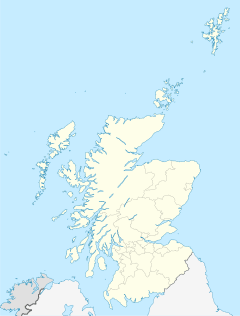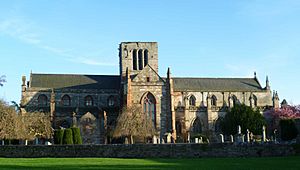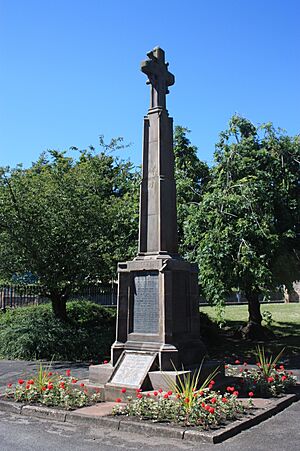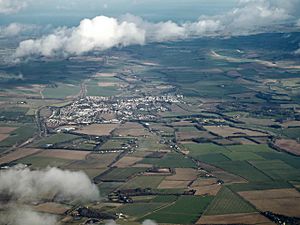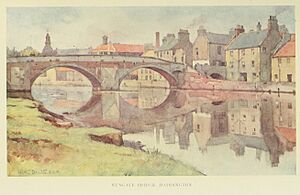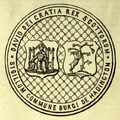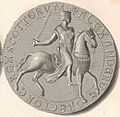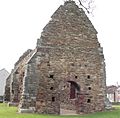Haddington, East Lothian facts for kids
Quick facts for kids Haddington
|
|
|---|---|
| Town and administrative centre | |
 A view of Haddington showing Haddington Town House with its added spire |
|
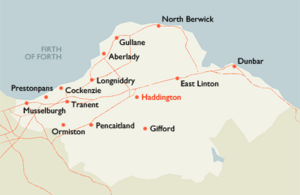 Administrative Centre for East Lothian |
|
| Population | 10,360 (2020) |
| OS grid reference | NT511739 |
| • Edinburgh | 17 mi (27 km) |
| • London | 393 mi (632 km) |
| Council area |
|
| Lieutenancy area | |
| Country | Scotland |
| Sovereign state | United Kingdom |
| Post town | HADDINGTON |
| Postcode district | EH41 |
| Dialling code | 01620 |
| Ambulance | Scottish |
| EU Parliament | Scotland |
| UK Parliament |
|
| Scottish Parliament |
|
Haddington is a historic town in East Lothian, Scotland. It's the main center for local government and culture in the area. The town is about 17 miles (27 km) east of Edinburgh.
The name Haddington comes from an old Anglo-Saxon word. It dates back to the 6th or 7th century AD. At that time, the area was part of the Kingdom of Bernicia. Later, in the 10th century, Haddington became part of Scotland. This happened when King Edgar of England gave the Lothian region to Scotland.
Haddington became a "Burgh" very early on, during the time of King David I (1124–1153). Being a burgh meant the town had special trading rights. This helped it grow into an important market town.
Today, Haddington is a smaller town with about 10,000 people. But in the High Middle Ages, it was one of the four biggest towns in Scotland! The Haddington Town House is a key building in the middle of town. It was finished in 1745. It used to have markets on the ground floor and a big hall upstairs. Other important buildings nearby include the corn exchange and the county courthouse.
You can also find the house where author Samuel Smiles was born. He was famous for his book Self Help. John Knox, a famous Scottish reformer, was probably born in Haddington too. The local high school, Knox Academy, is named after him.
Town Life and Business
Haddington is mostly located on the left side of the River Tyne. It was once well-known for its mills, which used the river's power. In the Middle Ages, Haddington grew to be the fourth-largest town in Scotland. Later, in the 1700s, it became a center for new farming methods during the Scottish Agricultural Revolution.
In the 1600s, there were efforts to make fine cloth in Scotland. Factories like the New Mills were set up. These factories faced challenges, but they showed the town's focus on industry.
As the main town of East Lothian, Haddington is where the East Lothian Council has its offices. These offices are in John Muir House. The town center has many unique local shops. You can find a bookshop, sports shop, butchers, and gift shops. There are also pubs, restaurants, and cafes. Bigger stores like Tesco and Aldi are also in Haddington.
Besides shops and local government, Haddington has law firms and some industrial businesses. The local newspaper, the East Lothian Courier, also has its offices here. A farmers' market is held in Court Street on the last Saturday of each month.
Historic Town Center
Haddington's town center still looks much like it did long ago. Streets like Court Street, High Street, Market Street, and Hardgate show where the old medieval market used to be. You can still see the old "rigg" pattern of plots. These were narrow buildings facing the main streets with long gardens behind them.
In the 1950s, Haddington started a special plan to improve its historic buildings. Many old properties were fixed up by the Town Council. A unique color scheme was also developed. This is why the town looks so colorful and distinctive today.
Some parts of the town were changed to make traffic flow better. But overall, the town center is now a conservation area. This means its historic character is protected. Many buildings are "listed," meaning they are important and old. Some even date back to the 1500s.
Important Landmarks
Haddington has many notable buildings. The old Abbey of St Mary and the 16th-century town defenses are mostly gone. But St Martin's Kirk is still one of the oldest and most important buildings.
Amisfield House
Amisfield House was a grand building east of Haddington. It was known as a very important example of Palladian architecture in Scotland. Sadly, the house was taken down in 1928 because of dry rot.
Today, only a few parts of Amisfield remain. These include the summer house, a walled garden, an ice house, a chapel, and the old gates.
Lennoxlove House
Lennoxlove House is a historic house and estate about half a mile (800 meters) south of Haddington. It was built in the 1200s and was first called Lethington. It was once home to the Maitland family. One famous resident was William Maitland of Lethington, who was Secretary of State to Mary, Queen of Scots. The house is now owned by the Duke of Hamilton and Brandon.
St Mary's Collegiate Church
The Parish Church of St Mary's is a very important church in Haddington. It is the longest parish church in Scotland. It is used regularly for church services and music events. The church is right next to the River Tyne and the old Nungate Bridge.
The current church building was started in 1375. An earlier church was destroyed by the English. The new church was finished in 1487. It was partly damaged during the Siege of Haddington in 1548-49. Later, it was restored. The church has a set of eight bells that were added for the Millennium. The Haddington War Memorial stands at the entrance to the churchyard.
Hailes Castle
Hailes Castle is a castle from the 1300s. It is about 5 miles (8 km) east of Haddington. The castle is in a beautiful spot by the river. It used to belong to the Hepburn family. Today, it is looked after by Historic Scotland and is open to the public for free.
Sports and Fun
Haddington has several sports clubs. These include the East Lothian Amateur Boxing Club and the football club Haddington Athletic. There is also a cricket club and the Haddington RFC rugby club.
The town's library moved to the John Gray Centre in 2012. This center is a group of old buildings that have been fixed up. It includes the town's old granary. The John Gray Centre has the lending library, historical archives, a museum about East Lothian, a computer room, and a community room. It is named after John Gray, a local minister who gave books and money to the town in 1717. This helped create one of Scotland's first community libraries.
Getting Around
Haddington is located about 1 km south of the A1 road. This major road connects Edinburgh to London. The town has bus services that can take you to Edinburgh, Berwick-upon-Tweed, and other towns and villages in East Lothian.
The closest train station is at Drem, about 4 miles (6 km) north of Haddington. You can catch trains from Drem to Edinburgh and North Berwick.
The Railway History
Haddington used to have its own railway line. This line branched off the East Coast Main Line at Longniddry and ended at Haddington railway station. The line was about 4.8 miles (7.7 km) long. It opened on June 22, 1846. Passengers from Haddington had to change trains at Longniddry to go to Edinburgh.
The railway line and station were damaged during a flood in 1948. Even though services started again, British Rail decided to close the passenger service on December 29, 1949. This was because of competition from buses and fewer passengers. Freight services continued until March 1968.
Today, the land where the railway line used to be is owned by East Lothian Council. It is now used by people for walking, cycling, and horse riding. Some parts of the old station buildings and walls can still be seen. There have been ideas to reopen the railway line to Haddington to help with road traffic. However, no plans have been put into action yet.
Town History Timeline
- Before 1139 - Haddington was given special "burgh" rights.
- 1178 – The Cistercian abbey of St Mary was founded. St Martin's Kirk was also built around this time. It is the oldest building still standing in Haddington.
- 1198 – King Alexander II of Scotland was born in Haddington.
- 1216 – Haddington was burned by the English army under King John.
- 1244 – Haddington was burned again. Several other Scottish towns also burned on the same night.
- 1282 – The first mention of a bridge over the River Tyne in Haddington.
- 1356 - The town was attacked by the army of Edward III of England. This event is known as the burnt Candlemas.
- 1375 – Work began on rebuilding St Mary's Church.
- 1462 – Building of St Mary's Church was completed.
- 1548-49 – The Siege of Haddington took place. English forces occupied the town, and Scottish and French troops then surrounded it.
- 1548 – July 7 – The Treaty of Haddington was signed. This agreement sent Mary Queen of Scots to France to marry the French heir.
- 1598 - Haddington was burned again, this time by accident.
- 1676 – The 'Ancient Fraternity of Gardeners of East Lothian' was started. This is the oldest known group of free gardeners.
- 1688 – John Gray started a town library.
- 1748 – The Haddington Town House was built.
- 1817 – The Waterloo Bridge was built. It was named after the Battle of Waterloo.
- 1830 – A spire was added to the Haddington Town Hall tower.
- 1846 – June 22 – Haddington's railway station opened.
- 1854 – The Corn Exchange was built. It is said to be the second largest in Scotland.
- 1948 – August 6 to 12 – A flood damaged much of the town.
- 1949 – December 5 – Haddington's railway station closed to the public.
- 1973 – The roof of the choir and other parts of St Mary's Church were repaired and renovated.
Famous People from Haddington
Many notable people have connections to Haddington:
- Alexander II (1198–1249), who was King of Scotland.
- Walter Bower (1385–1449), an early historian.
- John Brown of Haddington (1722–1787), a famous religious writer.
- Finlay Calder (born 1957) and Jim Calder (rugby player) (born 1957), Scottish rugby players.
- Jane Welsh Carlyle (1801–1866), a writer and wife of Thomas Carlyle.
- Fish (born 1958), a rock musician who lives in Haddington.
- William George Gillies (1898–1973), a painter who was born in Haddington.
- John Knox (1505–1572), a very important Protestant reformer, was likely born and educated in the town.
- John Mair (1467–1550), a Scottish philosopher and teacher of many famous people.
- Samuel Smiles (1812–1904), a social reformer and author of Self Help.
- Ada de Warenne (1120–1178), a Countess who founded the Nunnery that the Nungate area is named after.
- Willie Wood (born 1938), a bowls player who competed in many Commonwealth Games.
Churches in Haddington
Haddington has several churches:
Church of Scotland
- St. Mary's Parish Church
- Haddington West Parish Church
Roman Catholic
- St Mary's
Other Churches
- Haddington Community Church
- Holy Trinity Episcopal Church
- Haddington Elim Church
Local Government
Haddington is part of the East Lothian area for government. Douglas Alexander is the Member of Parliament (MP) for Lothian East. Paul McLennan is the Member of the Scottish Parliament (MSP) for East Lothian. There are also four local councillors who represent Haddington and Lammermuir.
Education
Haddington has three public primary schools: Haddington Primary School, St. Mary's RC Primary School, and Letham Mains Primary School. Haddington Primary and St. Mary's are near Neilson Park. Letham Mains is in the Letham estate on the west side of town.
For secondary school, students attend Knox Academy on Pencaitland Road. There is also an independent primary school called The Compass School.
Historically, Haddington's schools had a good reputation.
Art and Artists
Many artists have connections to Haddington. These include: Stephen Baillie, John Guthrie Spence Smith, William Darling McKay, Colin Thoms, William George Gillies, Daisy R. Sharp, Robert Noble, Shirley M. Maud, Walter Dexter, and Haugh.
Haddington on Film
Haddington has been featured in some films, such as:
- Lothian Landscape (1974)
- Lothians Part II, the: Industries and Towns (1956+)
Images for kids
-
Seal of Alexander II
-
Polish 1st Armoured Division stationed at Haddington in 1943, in preparation for D-Day
See also
 In Spanish: Haddington para niños
In Spanish: Haddington para niños


